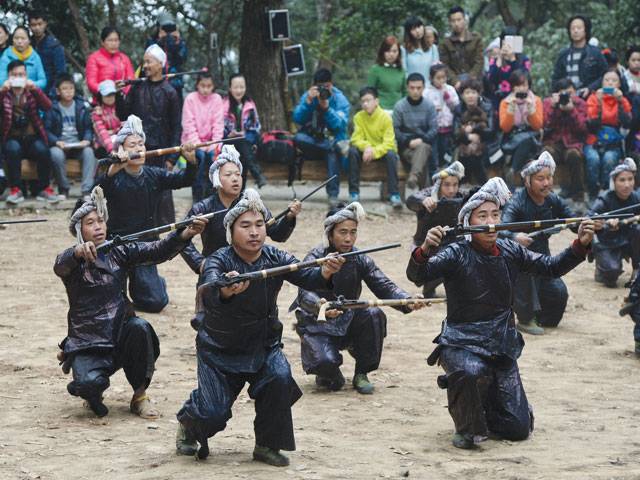BIASHA, China-A rifle shot tears the air of a mountain hamlet - met not with terror but cries of delight in China’s only remaining village where authorities encourage gun ownership.
“We start carrying guns from about 15 years old,” said Jia Xinshan, fingering a wooden rifle’s trigger as tourists snapped pictures of him in a shiny black coat. “We’re the last gun tribe in China.”
The armaments in Biasha, a village tucked amid the wooded peaks of Guizhou province, are a reminder of an era of conflict between Beijing and the mountain tribes who still inhabit swathes of China’s southwest.
Villagers are allowed to own rifles but restricted to firing them during displays for tourists - illustrating how once-restive minority groups have integrated with the state.
China, wary of social unrest and crime, bars most civilians from owning firearms, giving the village’s gunpowdery atmosphere an illicit feel.
“We used to use our guns to protect the village,” said Jia, 30, who performs daily in a dance routine where he thrusts his gun into the air before firing it. “Now we carry them to give tourists an impression.”
Biasha’s wooden shacks which cling to hillsides are home to members of the Miao minority, an ethnic group of about 12 million people who are more at home in their own languages than Mandarin Chinese.
The name “Miao” was first applied to hill tribes who fought bloody rebellions against the Chinese state which pushed south in the 1600s, forcing locals into high mountain territory.
Miao fighters had “considerable experience with firearms,” as early as 1681, according to historian Robert Jenks, whose account of the rebellion was published by the University of Hawaii. But the deadliest clashes occurred in the 19th century, where by some estimates several million died.
Chinese forces lost 30 to 40 men a day from Miao snipers who fired into government camps under cover of darkness, a British mercenary commented in 1870, according to Jenks.
The rebellions were finally put down and Miao leaders executed in 1872 by Chinese army regiments.
Mountain groups “went through a process of adaption to the new nation-state system,” said Siu-Woo Cheung, a professor at the Hong Kong University of Science and Technology.
The Miao achieved their first official recognition as an ethnic group by the republic that followed the collapse of China’s last dynasty in 1912, granting them limited autonomy, a status that continued when the Communist Party took power three decades later.
The Miao’s accommodation with the government contrasts with other groups such as Tibetans and Uighurs, who continue to clash with authorities over what they claim is cultural repression.
Villagers in Biasha said just one gun maker remains - in a hillside shack where vegetables hang from the roof and metal weapon scraps fill a wicker basket.
“It takes two or three days to make a gun,” said Gun Laosheng, the craftsman. “My father taught me, because he loved guns and was great at hunting wild birds.” But these days locals prefer to profit from tour groups, he said. “Now you spend a day hunting and you don’t even know if you’ll shoot anything, so it makes more sense to work and buy some meat.”
Many villagers have taken the surname Gun, whose similarity with the English word is coincidence.
Thursday, April 18, 2024
China village gunning for tourists

Caption: China village gunning for tourists
Mehwish Hayat says she would like to work with Aamir Khan
9:59 PM | April 18, 2024
'That'll be awesome,' Rohit Sharma on idea of Pakistan vs India Test series
9:17 PM | April 18, 2024
Turkiye commends Pakistan's efforts in fostering regional peace
9:03 PM | April 18, 2024
CM Maryam's security squad hits biker to death in Narowal
9:02 PM | April 18, 2024
Hafiz Naeemur Rehman sworn in as new emir of Jamaat-e-Islami
8:54 PM | April 18, 2024
Hepatitis Challenge
April 18, 2024
IMF Predictions
April 18, 2024
Wheat War
April 18, 2024
Rail Revival
April 17, 2024
Addressing Climate Change
April 17, 2024
Justice denied
April 18, 2024
AI dilemmas unveiled
April 18, 2024
Tax tangle
April 18, 2024
Workforce inequality
April 17, 2024
New partnerships
April 17, 2024
ePaper - Nawaiwaqt
Advertisement
Nawaiwaqt Group | Copyright © 2024





